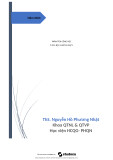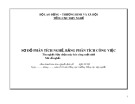
Chapter 27
Unemployment
David Begg, Stanley Fischer and Rudiger Dornbusch, Economics,
6th Edition, McGraw-Hill, 2000
Power Point presentation by Peter Smith

27.2
Some key terms
■Unemployment rate:
–the percentage of the labour force without a
job but registered as being willing and
available for work
■Labour force
–those people holding a job or registered as
being willing and available for work
■Participation rate
–the percentage of the population of working
age declaring themselves to be in the labour
force

27.3
Unemployment in the UK, 1950-99
0
2
4
6
8
10
12
14
1950
1970
1990
% p.a.
Source: Economic Trends Annual Supplement, Labour Market Trends

27.4
Unemployment (%) in selected countries
0
2
4
6
8
10
12
14
%
1972 1982 1999
UK Ireland France EU USA

27.5
Labour market flows
It is tempting to see the labour market in static terms
Working Unemployed
Out of the
labour force but...





![Bài giảng Phương pháp phân tích công việc thuộc chức năng nhiệm vụ [chuẩn SEO]](https://cdn.tailieu.vn/images/document/thumbnail/2020/20200721/chuakieudam/135x160/3491595296860.jpg)
![Hệ thống thang bảng lương theo chức danh công việc [mới nhất 2024]](https://cdn.tailieu.vn/images/document/thumbnail/2019/20190624/leoanh111/135x160/1211561339601.jpg)



















